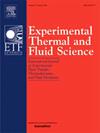Investigation of flow field structures induced by cavity geometry in supersonic Mach 2 conditions
IF 3.3
2区 工程技术
Q2 ENGINEERING, MECHANICAL
Experimental Thermal and Fluid Science
Pub Date : 2025-08-13
DOI:10.1016/j.expthermflusci.2025.111594
引用次数: 0
Abstract
This study utilizes particle image velocimetry (PIV) to analyze the flow field dynamics in cavity flame holders with varying geometries, emphasizing the quantitative effects of shear layer impingement location and cavity geometry on recirculation zone behavior. Experimental findings reveal that reducing the aft ramp angle weakens high-speed reverse flow near the bottom of the cavity, promoting increased circulation values and a more stable flow structure through the suppression of small-scale vortices. Moreover, as the cavity length-to-depth ratio (L/D) increases, the shear layer impingement location shifts further toward the cavity bottom, causing the primary recirculation zone to diminish or vanish. Concurrently, the secondary recirculation zone expands, leading to a decrease in both average vorticity and circulation values. Enhanced positive axial flow is also observed within the cavity, attributed to the interaction between the shear layer and three-dimensional flow dynamics. This study offers new insights into the transient flow behavior within cavities under supersonic conditions, emphasizing the role of shear layer impingement and recirculation characteristics. The findings provide valuable guidance for the design of cavity-based flameholders, bridging the gap between fundamental flow understanding and practical scramjet combustor applications.
超声速2马赫条件下空腔几何诱导的流场结构研究
本研究利用粒子图像测速技术(PIV)分析了不同几何形状的腔内火焰架的流场动力学,重点研究了剪切层撞击位置和腔内几何形状对再循环区行为的定量影响。实验结果表明,减小尾部坡道角可以减弱腔底附近的高速逆流,通过抑制小尺度涡促进循环值的增加和流动结构的稳定。此外,随着空腔长深比(L/D)的增加,剪切层冲击位置进一步向空腔底部移动,导致初级再循环区减小或消失。同时,二次再循环区扩大,导致平均涡度和环流值下降。由于剪切层和三维流动动力学之间的相互作用,在腔内也观察到增强的正轴流。该研究为超声速条件下腔内瞬态流动行为提供了新的见解,强调了剪切层撞击和再循环特性的作用。研究结果为基于腔的火焰支架的设计提供了有价值的指导,弥合了基本流动理解与实际超燃冲压发动机燃烧室应用之间的差距。
本文章由计算机程序翻译,如有差异,请以英文原文为准。
求助全文
约1分钟内获得全文
求助全文
来源期刊

Experimental Thermal and Fluid Science
工程技术-工程:机械
CiteScore
6.70
自引率
3.10%
发文量
159
审稿时长
34 days
期刊介绍:
Experimental Thermal and Fluid Science provides a forum for research emphasizing experimental work that enhances fundamental understanding of heat transfer, thermodynamics, and fluid mechanics. In addition to the principal areas of research, the journal covers research results in related fields, including combined heat and mass transfer, flows with phase transition, micro- and nano-scale systems, multiphase flow, combustion, radiative transfer, porous media, cryogenics, turbulence, and novel experimental techniques.
 求助内容:
求助内容: 应助结果提醒方式:
应助结果提醒方式:


